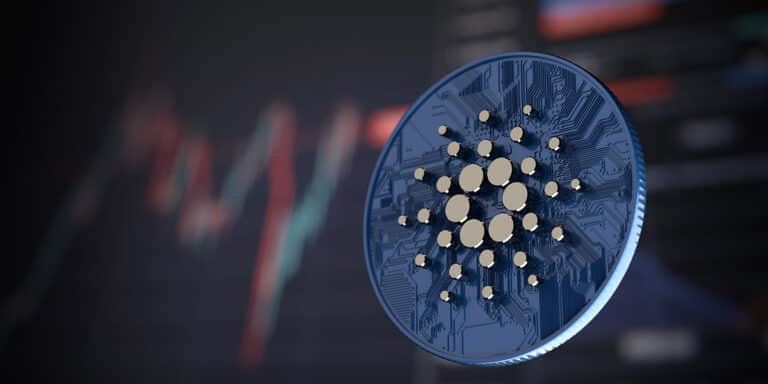Cardano Price Today
- Overall ranking: #9
- Coin
Cardano Price (ADA)
Market Cap
Market Capitalization is the overall value of all coins/tokens that have been mined or issued until now and are in circulation (not locked). It's similar to the stock markets' Free-Float Capitalization.
Market Capitalization = Circulating Supply x Current Price.
$24,459,022,509
2.19%
Fully Diluted Market Cap
FDMC is the Market Cap if the Maximum Supply of a coin/token was entirely in circulation.
FDMC = Max Supply x Current Price.
Note: if Maximum Supply is not available or limitless, Total Supply is used to calculate the value. FDMC will be undefined and marked as "--" if no form of Supply is available.
$31,231,279,700
2.19%
Trading Volume
$680,664,811
3.96%
Volume / Market Cap
0.0278
Circulating Supply
Publicly circulating amount of specific cryptocurrency coins/tokens that were mined or issued to date, and are not locked/staked (are available to be traded publicly).
Verified Data
Bitcoin project's Circulating Supply has been verified and is equal to:
Circulating Supply
Number
35,242,104,181.20 ADA 78.32%
Max Supply:
The absolute theoretical maximum number of coins/tokens that is coded and will ever exist in the cryptocurrency's lifetime. Similar to stock market's Fully Diluted Shares.
Note: Max Supply will be undefined and marked as "--" if project owners did not verify / provide any data.
45,000,000,000
Total Supply:
The quantity of all coins/tokens that have ever been issued (even if the coins are locked), minus all coins/tokens that have been removed from circulation (burned). The Total Supply is similar to stock market's Outstanding Shares
Total Supply = All Issued Coins - Burned Coins.
Note: Total Supply will be undefined and marked as "--" if project owners did not verify / provide any data.
35,242,104,181
Cardano (ADA) to USD Chart
ADA to USD Converter

Cardano
The current real-time Cardano price is $0.69 . ADA price has plummeted by 2.19% in the last day and decreased by 2.24% in the last seven days. It’s important to note that the current Cardano market capitalization is $24,459,022,509. The maximum supply is 45,000,000,000.00 ADA, with a circulating supply of 35,242,104,181.20. ADA is ranked #9 in terms of market cap.
Cardano In A Nutshell
Cardano is a Proof-of-Stake (PoS) cryptocurrency that was launched in 2017 by Ethereum co-founder Charles Hoskinson. The project was designed with sustainability in mind and aims to reduce blockchain energy consumption.
As Cardano is a layer one cryptocurrency, other decentralized applications (dApps) can be built on the network, similar to Ethereum. Any projects built on the Cardano network benefit from its security and efficiency but must use ADA to pay transaction costs, increasing demand for the asset. Learn more about what Cardano is and how to buy Cardano.
How Cardano Works – The Basics
Cardano is a Proof-of-Stake (PoS) cryptocurrency, meaning that transactions on the network are approved by validators who run a full node or participate in a staking pool. As more users pledge ADA and participate in staking pools, the network benefits from greater decentralization and security. There is no minimum staking requirement on the network.
As a layer one blockchain, the primary function of the Cardano network is to provide efficient architecture facilitating the development and execution of decentralized applications (dApps) and smart contracts. It's important to understand that while Cardano is a blockchain, ADA is the proprietary token used for staking and paying transaction fees.
The Cardano consensus mechanism comprises two critical layers. The settlement layer is designed to process transactions on the network and uses a similar model to Bitcoin. A control layer that manages the blockchain's integrity and conducts verification is also used on the network.
Transactions on Cardano are efficient, settle quickly, and are low-cost compared to networks like Bitcoin or Ethereum. On average, a transaction costs around 0.25 ADA, while settlement takes just 15 seconds.
What's Unique About Cardano
A significant advantage of Cardano versus other networks is how updates and new technologies are approved. Instead of a project lead pushing updates as they please, Cardano utilizes a peer-review process that invites pushback and discussion of new ideas. Moreover, this approach provides greater security as updates are scrutinized more rigorously.
The entire code for Cardano is open source and publicly viewable. Users can browse the code to verify it's not malicious and to help find and patch potential exploits. Moreover, the project's open-source nature allows users to develop and propose new functions and improvements.
Another benefit of Cardano versus other crypto networks is its lack of downtime when updates are deployed. Instead of the network going down temporarily, updates on Cardano can be pushed while the network remains live, resulting in superior uptime and making it easier to update.
What Can ADA Be Used For After Purchase?
1. Governance
Cardano’s addition of smart contracts to the blockchain has substantially expanded the scope and potential use-case of ADA tokens. Those who have taken a keen interest in the Cardano operations may wish to use their ADA to participate in the community. This can be as simple as briefly locking up ADA to vote on governance proposals. This gives investors a way to shape the future direction of Cardano, much like a major shareholder might with a traditional business.
A broad range of categories for interested voters to browse through include project development, dApp integrations, GameFi, and migrating applications from Ethereum to Cardano.
2. Decentralized apps
Only about 70 dApps have been developed atop the Cardano infrastructure, but there are still gems to be found that can make the most of ADA being held in a wallet. P2P trading on AtomicSwap, NFT collecting on Artano and earning via a P2E game are all viable options. A full list of dApps on the Cardano blockchain can be found here.
3. Stake ADA
ADA holders can maximize their investments by participating in staking. ADA can be transferred to a supported wallet – such as Daedalus – and then lent to a staking pool to earn additional ADA as a reward. Alternatively, certain exchanges will offer in-house staking, meaning users won’t have to go through a third-party application.
The rewards for staking Cardano are largely dependent on how many others are already staking. Cardano has quite an active community, and about 70% of the staking limit is being staked as of mid-2022. Stakers that delegate to a pool can expect rewards of around 5% per annum.
4. Pay for goods and services
ADA can be used as a medium of exchange and has found some success with this. The network has very competitive gas fees, usually around 20 cents USD per transaction, which makes it much more efficient than the likes of BTC and ETH. An industry-specific use case for Cardano is in the agricultural sector, where businesses use it as a supply chain management tool to track produce.
5. Earn interest on ADA
Investors can earn different interest rates on Cardano depending on the crypto interest platforms. Providers such as Nexo allow their users to earn up to an 8% interest rate on Cardano. There are certain requirements to obtain the highest interest rate on Cardano. However, the rate of return is better than leaving the ADA tokens idle in a wallet. With Cardano interest accounts, the rewards will not offset losses in a bear market but can provide a great source of passive income in the long term.
Cardano Price History
Investors were first introduced to Cardano through a public Initial Coin Offering (ICO) held from 2015 to 2017 in which $62 million worth of ADA was sold for just $0.0024, meaning ICO investors are in around 17,000% profit based on current prices.
ADA was publicly released in October 2017 at around $0.02461. However, ADA climbed substantially in late 2017 and early 2018, hitting $0.996 by January 2018, a return of around 3947% against its public launch. Despite an impressive start to the year, ADA struggled throughout the remainder of 2018, finishing the year around $0.031 as early investors sold ADA.
Throughout 2019 and 2020, ADA experienced little movement, hovering between $0.05 and $0.10 as the market struggled to gather steam for another upward movement.
However, in 2021, fueled by the bull run and anticipation of Cardano's Alonzo upgrade, which added smart contract support, ADA exploded, hitting $1.46 in May before climbing to an all-time high of $2.9593 in December.
Since hitting its all-time high, ADA has been in a downward trend save for a brief spike to around $0.75 in March 2024. Today, ADA trades for around $0.42.
Cardano Circulating Supply
There are 35,242,104,181.20 ADA in circulation out of a maximum supply of 45,000,000,000.00 ADA tokens. When the token launched, investors purchased 25,927,070,538 ADA via an Initial Coin Offering (ICO), with 20% of that figure, or 5,185,414,108 ADA allocated to the Cardano Foundation, OPHK, and EMURGO. The remainder of the supply is reserved to pay staking rewards to validators.
Share text copied successfully!

 Share
Share 
 Website
Website  Explorers
Explorers  Community
Community  Source Code
Source Code  Whitepaper
Whitepaper 
